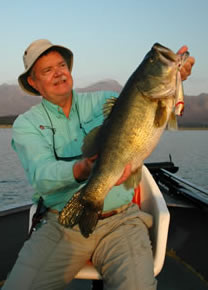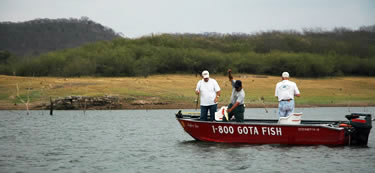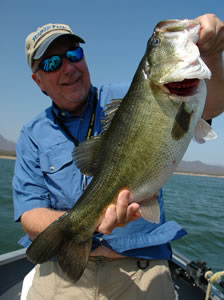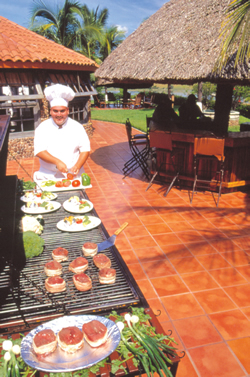February 11, 2015
By Larry Larsen
Lake El Salto is Mexico's hottest Florida-strain bass factory.

Larry Larsen discovered excellent topwater action where a shallow cut transitioned to a 20-foot dropoff. Larsen has been on numerous Mexico bass fishing trips. |
A glimmer of light silhouetted arid foothills as we motored through flooded timber and around a few small islands into the main arm of the big lake. Our guide, Carlos, headed straight toward our topwater hole, a 200-yard stretch of pastureland bank broken by two wide, shallow cuts.
A sharp dropoff into 20 feet of water made the edge ideal for topwater, and an overcast sky and a moderate wind promised an extended bite. Dave Burkhardt of Clermont and I were sampling Lake El Salto in northwestern Mexico. Both of us love topwater fishing, and we'd had maybe an hour of surface activity on the first two days of our trip, primarily right at this same spot.
Largemouth bass were breaking the surface as we pulled up and dropped the trolling motor. Dave tossed to one splash while I shot my bait at another one. It was not our first double or even our tenth, but our confidence boost was maxed out. The two fish, weighing somewhere between three and four pounds, were quickly brought to the boat and released.
Dave again tossed the edge of the drop in front of the thin-water cut and was walking his cigar-type minnow back along the surface when a big fish tore into it and headed for the depths. He set back on the rod and hung on. Fortunately, the bass headed away from the only visible submerged tree in that area.
“Keep it coming up,” Carlos instructed. “There are some trees below the surface too.”
“How big is it?” I asked, straining to catch a glimpse of the fish.
“Don't know,” Dave replied, as he ran forward to the bow and held his rod high as I ducked under it. The fish circled the boat and wallowed on the surface about 20 feet out.

Submerged timber comprises a great deal of habitat on El Salto. |
“That's a butterball,” I said as our guide slipped the net under the fish.
“Or a watermelon,” my excited partner quipped. “It should go 10 pounds!”
The fish had a small head and fat body on a relatively short frame. The proportions made guessing difficult for us Florida boys. Both Dave and Carlos had sworn the first day that one of my big fish was a 10-pounder. It weighed a little over 9 on our scale.
Dave's fish was shorter, but a lot fatter. It looked huge to me. We had it on the scale soon and they were right on this one: Almost 10 1/2 pounds.
Fish continued to feed on or near the surface in the dim light. My biggest of the day was maybe three inches longer than Dave's but was much leaner. Compared to the typical bass we catch in Florida, it was on the plump side for sure.
My hopes for a double-digit fish were dashed when the scale showed only 9 3/4 pounds. Still, that's a nice fish anywhere and I was happy.
We headed to the Anglers Inn for lunch and a siesta at 11 a.m. We had landed 100 largemouths of varying sizes and some 80 of them on topwater plugs. Most were 3 to 5 pounds and plenty were 6 or 7.
We added another 60 bass to our day's tally after lunch on Texas- and Carolina-rigged worms and crankbaits. It was a big day for us, but the first two hadn't been too shabby, either. Dave and I had caught and released 100 on day one up to 9 pounds and 80 on day two.
Lake El Salto, at the base of the Sierra Madre Mountains, only 90 minutes from the coastal resort city of Mazatlan, is not just a numbers lake. These waters today have Mexico's biggest largemouth bass, according to Burkhardt. This was his tenth visit to a lake where he has averaged two 10-plus pounders on each of his previous ventures. His biggest was a whopper 15-pound, 2-ounce largemouth, and on that day, his five largest bass totaled a little over 52 pounds!

Dave Burkhardt (fishing below) hoists a typical El Salto "football." |
The lake record at Lago El Salto is 18 pounds, 8 ounces, caught in May 2002, according to resort manager “Chappy” Chapman. Chappy, who is the 28-year-old son of Anglers Inn owner Billy Chapman Jr., has been working at the resort for most of his adult life.
“The growth of these fish has been phenomenal,” he explains. “My father and grandfather stocked the lake as it was filling (at about 3,000 acres) with 60,000 Florida bass fingerlings in 1985 and opened a lodge in 1990. In 1995, we found a dead 16-pounder floating on the surface with a tilapia stuck in its throat. For a largemouth to grow to 16 pounds in just 10 years is tremendous.”
From what we can tell, Lake El Salto should be at or near the top of the list of Mexican bass lakes for some time. But keep in mind it's an impressive list.
The big reservoirs in Mexico are attractive to U.S. anglers for a number of reasons. For one, the lakes typically produce better numbers and sizes of largemouth bass than do most U.S. waters, even in Florida. Very seldom do visitors have a slow day on El Salto or any other Mexican bass lake. Mild weather makes for an extended growing season, and there is very little fishing pressure or predation on the lakes. Package prices including guide, boat, food and accommodations, are very reasonable considering the dollar to peso exchange rate and wages south of the border.
The Mexican government seems to build a new lake every 5 to 10 years; ground breaking to complete filling can take up to 15 years. In the next 10 years, Chappy's father Billy Chapman Jr. expects to see two or three more reservoirs in the range of 20,000 to 70,000 acres. Most of the lakes are built initially for irrigation purposes, strictly for opening up new farmland nearby and not for hydroelectric generation. Several years later, some will become hydroelectric producers when regional needs warrant.
Today there are about 17 impoundments on the west slope of the Sierra Madre Mountains, and about five on the east side. The mountain range starts around El Paso, Texas, and runs down the center of Mexico. Most of the steeper gradients with substantial rivers drain to the west into the Pacific Ocean, and that's why the Mexican government has created more reservoirs on that side.
From the day largemouth bass fry are stocked in the initial backup of water, it normally takes five years before they and the lake mature enough to support quality fishing. Tilapia are the main forage, and these fish are stocked by the government to provide a source of revenue to villagers displaced by the impoundments. The tilapia netting seldom impacts the bass fishery.
Mother Nature takes care of everything else. A lake is typically a “numbers” lake before fish grow to trophy proportions. Typical growth rate on a new lake is 1 11/2 to 2 pounds a year. The fishing for bigger fish starts getting good in five years when the bass are 8 to 10 pounds. The numbers may drop off some then.
“On almost every new lake in Mexico, the big fish after four years is 8 pounds,” says Billy Chapman Jr., “and then they are 10 pounds after five years. As some lakes get older than that, they don't continue to see the 2-pound-per-year growth rate in their bass.”
He should know, after outfitting clients on several Mexican bass lakes for over 29 years. Billy Jr. began his Mexico outfitting career in 1973 when he went to work as a fishing guide on Lake Dominguez for his outfitter father, Billy Chapman Sr. In 1975, his father stocked Florida bass into the newly flooded reservoir called Lake Baccarac. Billy Jr. opened up a new operation for his dad on that lake in 1980 and hosted thousands of visiting anglers during its heydays in the early 1980s.

Grilled lunch at Anglers Inn. |
In 1985, Billy Jr. stocked 200,000 Florida-strain largemouth fry from a fish hatchery in Houston into the newly formed Lake El Salto. He opened a mobile lodge at El Salto in 1990 and has been on the lake for most of the 15 years since. He briefly moved his lodge to Lake Comedero in 1993 and 1994 and to Lake Huites in 1997 and 1998, but he didn't have the success he had hoped for, so he returned to El Salto each time.
Formed by the damming of the Elota River, Lago El Salto has 45 miles of shoreline and numerous rocky islands to fish around. There are plenty of submerged mesquite tree forests and hilltops, creek channels and a couple of flooded cemeteries. Forage sources include tilapia, as well as threadfin and gizzard shad and crawfish. The lake varies from about 24,000 surface acres at full pool to 16,000 at the end of the dry season in May or June. Day-to-day water levels are fairly consistent, as the lake is not connected to another lake and the only water leaving is for irrigation of the fields around the area. On a chain of lakes, such as Lake Dominguez at the bottom, then Lake Hidalgo and finally Lake Huites above, water can be released quickly from one of the upper “holding-type” reservoirs to fill a lower one.
“That can affect the levels greatly,” says Chappy. “I've seen the water fluctuate 30 feet overnight on Huites when Hidalgo needed water and got it.”
Agua Milpa is the newest Mexican lake, and Chapman has property there, but the government is building another lake above it called El Cajon. It may be 4 to 6 years away from completion, and that lake will be a holding lake for Agua Milpa, according to Chappy. Consequently, it will fluctuate a lot more than the lower lake, and the Chapmans decided not to operate at Agua Milpa for the time being.
“We always ended up coming back to El Salto,” says Billy Jr., “and until there is a better Mexican lake to fish, I'm not moving anywhere.”
What's There
The Anglers Inn Mexico facility on the shores of Lake El Salto offers very comfortable, air-conditioned accommodations for up to 46 anglers. The lakeside resort features excellent service from the “welcome” margarita, to the morning wake-up call with juice/coffee service, to the just-off-the-lake appetizer of quesadillas, nachos or beef burritos and favorite beverage, to the open bar and great cook-to-order food variety. Other amenities include massage service, laundry service, telephone and Internet service, full-service tackle shop, safe bottled water, and satellite TV in bar and dining areas (and soon to be in the guest rooms).
Continental Airlines and others fly to Mazatlan where one of the resort vans will greet you and transfer you to Lake El Salto. Billy Chapman, Jr. offers 3-day and 4-day packages at Anglers Inn, as well as daytrips and longer stays. He even offers a “Steel Thunder” Bass & Bikes tour of the scenic Sierra Madre Mountains and Lake El Salto for those who want to ride a Harley through the new frontiers before or after the fishing. The resort is normally open from October through July. For more information on the bass fishing packages at Anglers Inn, call (800) GOTA FISH (800-468-2347),
e-mail info@anglersinn.com or visit their website at
www.anglersinn.com/.
FS
First Published Florida Sportsman January 2006
About the Author
Click Here to Have Florida Sportsman Magazine Delivered to Your Home

